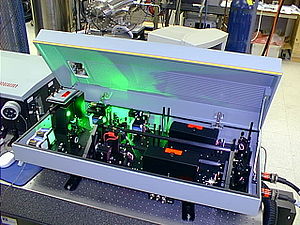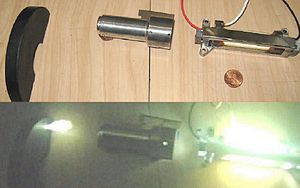- Nd:YAG laser
-
Nd:YAG (neodymium-doped yttrium aluminium garnet; Nd:Y3Al5O12) is a crystal that is used as a lasing medium for solid-state lasers. The dopant, triply ionized neodymium, typically replaces yttrium in the crystal structure of the yttrium aluminium garnet (YAG), since they are of similar size. Generally the crystalline host is doped with around 1% neodymium by atomic percent.[1]
Laser operation of Nd:YAG was first demonstrated by J. E. Geusic et al. at Bell Laboratories in 1964.[2]
Contents
Technology
Nd:YAG lasers are optically pumped using a flashtube or laser diodes. These are one of the most common types of laser, and are used for many different applications. Nd:YAG lasers typically emit light with a wavelength of 1064 nm, in the infrared.[3] However, there are also transitions near 940, 1120, 1320, and 1440 nm. Nd:YAG lasers operate in both pulsed and continuous mode. Pulsed Nd:YAG lasers are typically operated in the so called Q-switching mode: An optical switch is inserted in the laser cavity waiting for a maximum population inversion in the neodymium ions before it opens. Then the light wave can run through the cavity, depopulating the excited laser medium at maximum population inversion. In this Q-switched mode, output powers of 250 megawatts and pulse durations of 10 to 25 nanoseconds have been achieved.[4] The high-intensity pulses may be efficiently frequency doubled to generate laser light at 532 nm, or higher harmonics at 355 and 266 nm.
Nd:YAG absorbs mostly in the bands between 730–760 nm and 790–820 nm.[3] At low current densities krypton flashlamps have higher output in those bands than do the more common xenon lamps, which produce more light at around 900 nm. The former are therefore more efficient for pumping Nd:YAG lasers.[5]
The amount of the neodymium dopant in the material varies according to its use. For continuous wave output, the doping is significantly lower than for pulsed lasers. The lightly doped CW rods can be optically distinguished by being less colored, almost white, while higher-doped rods are pink-purplish.
Other common host materials for neodymium are: YLF (yttrium lithium fluoride, 1047 and 1053 nm), YVO4 (yttrium orthovanadate, 1064 nm), and glass. A particular host material is chosen in order to obtain a desired combination of optical, mechanical, and thermal properties. Nd:YAG lasers and variants are pumped either by flashtubes, continuous gas discharge lamps, or near-infrared laser diodes (DPSS lasers). Prestabilized laser (PSL) types of Nd:YAG lasers have proved to be particularly useful in providing the main beams for gravitational wave interferometers such as LIGO, VIRGO, GEO600 and TAMA.
Applications
Medicine
 Slit lamp photo of posterior capsular opacification visible few months after implantation of intraocular lens in eye, seen on retroillumination
Slit lamp photo of posterior capsular opacification visible few months after implantation of intraocular lens in eye, seen on retroillumination
Nd:YAG lasers are used in ophthalmology to correct posterior capsular opacification, a condition that may occur after cataract surgery, and for peripheral iridotomy in patients with acute angle-closure glaucoma, where it has superseded surgical iridectomy. Frequency-doubled Nd:YAG lasers (wavelength 532 nm) are used for pan-retinal photocoagulation in patients with diabetic retinopathy.
In oncology, Nd:YAG lasers can be used to remove skin cancers.[6]
These lasers are also used extensively in the field of cosmetic medicine for laser hair removal and the treatment of minor vascular defects such as spider veins on the face and legs. Recently used for dissecting cellulitis, a rare skin disease usually occurring on the scalp.
Using hysteroscopy the Nd:YAG laser has been used for removal of uterine septa within the inside of the uterus.[7]
In podiatry, the Nd:YAG laser is being used to treat onychomycosis, which is fungus infection of the toenail.[citation needed] The merits of laser treatment of these infections are not yet clear, and research is being done to establish effectiveness.[8][9]
Manufacturing
Nd:YAG lasers are also used in manufacturing for engraving, etching, or marking a variety of metals and plastics. They are extensively used in manufacturing for cutting and welding steel, semiconductors and various alloys. For automotive applications (cutting and welding steel) the power levels are typically 1–5 kW. Super alloy drilling (for gas turbine parts) typically uses pulsed Nd:YAG lasers (millisecond pulses, not Q-switched). Nd:YAG lasers are also employed to make subsurface markings in transparent materials such as glass or acrylic glass. Lasers of up to 400 W are used for selective laser melting of metals in additive layered manufacturing.
Fluid dynamics
Nd:YAG lasers can also be used for flow visualization techniques in fluid dynamics (for example particle image velocimetry or laser induced fluorescence).[10]
Dentistry
Nd:YAG lasers are used for soft tissue surgeries in the oral cavity, such as gingivectomy, periodontal sulcular debridement, LANAP, frenectomy, biopsy, and coagulation of graft donor sites.
Military and defense
The Nd:YAG laser is the most common laser used in laser designators and laser rangefinders.
Cavity ring-down spectroscopy (CRDS)
The Nd:YAG may be used in the application of cavity ring-down spectroscopy, which is used to measure the concentration of some light-absorbing substance.
Laser-induced breakdown spectroscopy (LIBS)
Main article: Laser-induced breakdown spectroscopyA range of Nd:YAG lasers are used in analysis of elements in the periodic table. Though the application by itself is fairly new with respect to conventional methods such as XRF or ICP, it has proven to be less time consuming and a cheaper option to test element concentrations. A high-power Nd:YAG laser is focused onto the sample surface to produce plasma. Light from the plasma is captured by spectrometers and the characteristic spectra of each element can be identified, allowing concentrations of elements in the sample to be measured.
Laser pumping
Nd:YAG lasers, mainly via their second and third harmonics, are widely used to excite dye lasers either in the liquid[11] or solid state.[12] They are also used as pump sources for vibronically broadened solid-state lasers such as Cr4+:YAG or via the second harmonic for pumping Ti:sapphire lasers.
Additional frequencies
For many applications, the infrared light is frequency-doubled or -tripled using nonlinear optical materials such as lithium triborate to obtain visible (532 nm, green) or ultraviolet light. Cesium lithium borate generates the 4th and 5th harmonics of the Nd:YAG 1064 nm fundamental wavelength. A green laser pointer is a frequency doubled Nd:YVO4 DPSS laser. Nd:YAG can be also made to lase at its non-principal wavelength. The line at 946 nm is typically employed in "blue laser pointer" DPSS lasers, where it is doubled to 473 nm.
Physical and chemical properties of Nd:YAG
Properties of YAG crystal
- Formula: Y3Al5O12
- Molecular weight: 596.7
- Crystal structure: Cubic
- Hardness: 8–8.5 (Moh)
- Melting point: 1950 °C (3540 °F)
- Density: 4.55 g/cm3
Refractive index of Nd:YAG
Wavelength (μm) Index n (25°C) 0.8 1.8245 0.9 1.8222 1.0 1.8197 1.2 1.8152 1.4 1.8121 Properties of Nd:YAG @ 25°C (with 1% Nd doping)
- Formula: Y2.97Nd0.03Al5O12
- Weight of Nd: 0.725%
- Atoms of Nd per unit volume: 1.38×1020 /cm3
- Charge state of Nd: 3+
- Emission wavelength: 1064 nm
- Transition: 4F3/2 → 4I11/2
- Duration of fluorescence: 230 μs
- Thermal conductivity: 0.14 W·cm−1·K−1
- Specific heat capacity: 0.59 J·g−1·K−1
- Thermal expansion: 6.9×10−6 K−1
- dn/dT: 7.3×10−6 K−1
- Young's modulus: 3.17×104 K·g/mm−2
- Poisson's ratio: 0.25
- Resistance to thermal shock: 790 W·m−1
References and notes
- ^ Koechner §2.3, pp. 48–53.
- ^ Geusic, J. E.; Marcos, H. M.; Van Uitert, L. G. (1964). "Laser oscillations in nd-doped yttrium aluminum, yttrium gallium and gadolinium garnets". Applied Physics Letters 4 (10): 182. Bibcode 1964ApPhL...4..182G. doi:10.1063/1.1753928.
- ^ a b Yariv, Amnon (1989). Quantum Electronics (3rd ed.). Wiley. p. §10.3, pp. 208–211. ISBN 0-471-60997-8.
- ^ Walter Koechner (1965) Solid-state laser engineering, Springer-Verlag, p. 507
- ^ Koechner §6.1.1, pp. 251–264.
- ^ Moskalik, K; A Kozlov, E Demin, and E Boiko (2009). "The Efficacy of Facial Skin Cancer Treatment with High-Energy Pulsed Neodymium and Nd:YAG Lasers". Photomedical Laser Surgery 27 (2): 345–9. doi:10.1089/pho.2008.2327. PMID 19382838.
- ^ Yang J, Yin TL, Xu WM, Xia LB, Li AB, Hu J. (2006). "Reproductive outcome of septate uterus after hysteroscopic treatment with neodymium:YAG laser". Photomed Laser Surg. 2006 Oct;24(5):625. 24 (5): 625. doi:10.1089/pho.2006.24.625. PMID 17069494.
- ^ Mozena, John; Haverstock, Brent (May 2010). "Laser care for onychomycosis: can it be effective?". Podiatry Today 23 (5): 54–59. http://www.podiatrytoday.com/laser-care-for-onychomycosis-can-it-be-effective.
- ^ Mozena, John D.; Mitnick, Joshua P. (October 2009). "Emerging concepts in treating onychomycosis". Podiatry Today 22 (10): 46–51. http://www.podiatrytoday.com/emerging-concepts-in-treating-onychomycosis.
- ^ Palafox, Gilbert N.; Wicker, Ryan B.; and Elkins, Christopher J. (2003). "Rapid in-vitro physiologic flow experimentation using rapid prototyping and particle image velocimetry" (pdf). 2003 Summer Bioengineering Conference: 419. http://www.tulane.edu/~sbc2003/pdfdocs/0419.PDF. Retrieved 2007-10-10.
- ^ F. P. Schäfer (Ed.), Dye Lasers (Springer-Verlag, Berlin, 1990).
- ^ F. J. Duarte, Tunable Laser Optics (Elsevier-Academic, New York, 2003).
Categories:- Solid-state lasers
- Dental lasers
- Ophthalmology
- Laser medicine
- Medical equipment
Wikimedia Foundation. 2010.




